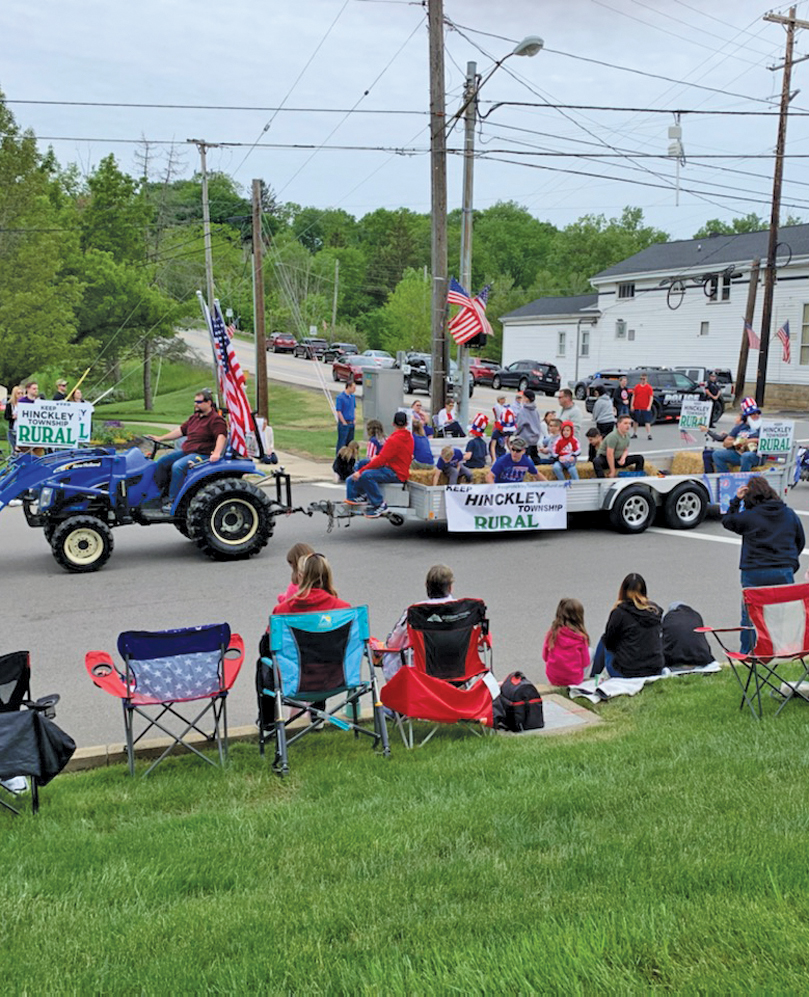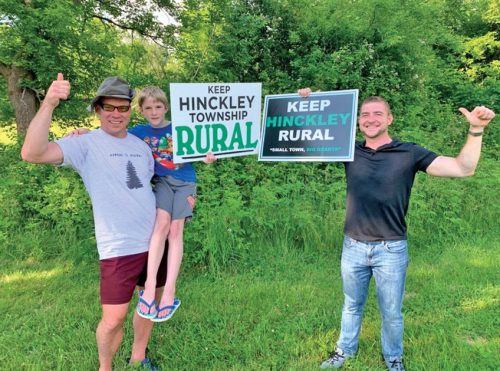Residents propose increasing minimum lot sizes, decreasing density
by Melissa Martin
Hinckley resident Matt Riley unexpectedly struck a nerve this past spring when he created a Facebook page and posted a sign outside his River Road home, both of which read “Keep Hinckley Rural.”
His message may have been a simple one, but to many of his neighbors, it appears to have been the rally cry they’d been waiting for.
Over the past several weeks, Riley’s sentiment and his signs have spread like wildfire in all corners of the township. Not only have more than 130 residents subscribed to the Keep Hinckley Township Rural Facebook page, but more than 300 signs are now in the ground, with more being requested daily.
“I’ve been watching as so much development has been happening all over the township,” Riley said. “Seeing quite a few large farms hit the market recently with the potential for even more, it’s really started to worry me.”
Based on the sheer number of signs sprouting daily in the community, Riley isn’t alone. Like many township residents, he moved to Hinckley from a Cleveland suburb – in this case, Brecksville – three years ago with his wife and three children. The Rileys were drawn to northeastern Medina County for its rural character – the wildlife, rolling hills and wide-open spaces.
“We all have our own stories to tell as to why we came here and why we’ve stayed. For me, it was the unbelievable amount of nature in a place that offered more freedom than living in a city,” Riley, 42, said.

With space, he said, comes more options. In his case, Riley said it’s long been a dream of his to plant an orchard in his backyard where he could raise various seasonal crops, in addition to apples, blueberries and more. More importantly, he could pass both that knowledge and the experience along to his children.
“When you have more space like we do, your property almost becomes more like a homestead and there’s just so much more you can do,” he said, citing the township’s lack of a noise ordinance as an example. That means he and other township residents are free to enjoy fireworks, riding ATVs and more.
For that reason alone, Riley said, sitting back and watching what he’s come to appreciate most about his community fade away, simply isn’t an option.
“This is not about the past or where we’ve been,” Riley said. “It’s all about protecting the future. It’s about preserving the precious green space we all love.”
A call to action
With hundreds of residents now behind him, Riley made a formal presentation to Hinckley’s Board of Trustees June 15, citing the goals of the Keep Hinckley Rural movement. In front of a packed town hall, with additional residents viewing the meeting virtually, he said the group is looking to expand the size of lots in areas zoned R-1 Residential District from the current 2 acres to 5 acres, thereby restricting the number of properties that can be built on any given plot of land.
If successful, this would be the second time the township changed its R-1 zoning. The last time was in 1975, when the township increased lot size minimums from ¾-acre to 2 acres.
Riley believes the 2-acre minimums are no longer sufficient and need to be increased if the township wants to preserve its country-like charm and not fall victim to becoming “just another suburb.”
“The simple answer is, if we want to protect the future of Hinckley the way we know it, we need to space out and have less density,” he said.
Riley encouraged trustees to “act immediately,” citing that based on county data, the average lot size in Hinckley Township was 4.75 acres in 2001. In 2021, he said, that number fell to 4.24 acres. Should the trend continue without the township taking action to amend its zoning, that density is only expected to increase over time.
“This is a one-way street. Once these lands are improved and developed, there is no going back. This is permanent and irreversible,” Riley told trustees, adding that based on current figures, the average lot size in Hinckley is expected to be 3.77 acres by 2040.
Riley suggested Hinckley trustees explore Medina Township’s Open Conservation Zoning, which calls for single-family residences to be built on lots with 5-acre minimums. The justification for using OC zoning in some areas, he said, is to protect its ecological, historical and scenic character and to prevent erosion, soil loss and protect the area’s unique topography, which includes gently rolling hills, rocky bluffs and cliffs.
Though 5-acre minimums would be ideal, Riley said he realizes that may not be possible. However, with more new developments on the horizon and 95% of the township’s remaining developable land located in the R-1 district, he believes that “even a change to 3- to 4-acre minimum lot sizes would be considered a win.”
“As the old saying goes, if it’s not broken, don’t fix it,” Riley told trustees. “But I’m here to tell you, it’s broken … and I’m asking you to do something now before permanent, irrevocable harm is done.”
Formulating a plan
The board of trustees indicated they are in agreement with the concept of preserving Hinckley’s rural character, but reminded residents that changing the township’s zoning is a process that will take time and careful planning. Due to the COVID-19 pandemic, Trustee Melissa Augustine said the results of the 2020 census – which contains numbers and figures that are crucial to planning for the future – have been delayed. The information contained in the report, however, is vital to making long-term decisions for the township.
Once the census data is received, Trustee Chris Kalina said the township will be able to proceed with conducting a cost of services study and possibly even a survey of township residents to determine if and how to proceed with zoning changes.
“We all want to keep Hinckley rural. It’s something we’re all passionate about,” he assured township residents. “But first, we have to smartly figure out how to get our questions answered and go from there.”
Kalina, who was instrumental in changing residential lot sizes from 2 to 3 acres when he served as a trustee in Medina Township, said proceeding cautiously with any zoning changes is particularly imperative given the potential impacts such action could have on several of the city’s existing residents.
“When you change lot sizes, you can cause problems and devalue property,” he said. “You really don’t want to create nonconforming lots.”
Trustee Jim Burns said that while he favors keeping the township’s rural character, he believes moving to 5-acre lot size minimums is “overreaching” and possibly even an example of government overstepping its boundaries.
“I like this environment and want to keep it, too,” he said, noting that aesthetics alone is not legal ground when it comes to zoning. “If [changing the zoning] is what we decide we want to do, we have to find a way to do it without infringing on other people’s rights.”
Though trustees proposed waiting for the township’s next comprehensive plan review, expected to take place in 2025, to consider amending residential zoning, those in favor of increasing minimum lot sizes say four years is too long to wait given the prospective development on the horizon.
“As long as there are loopholes, developers are going to keep taking advantage of them,” township resident Jim Larson told the board. Unfortunately, we just keep going back after the fact and trying to change the loopholes, and we can’t keep doing that.”
Larson and several other residents in attendance at the June 15 meeting asked what residents can do to help move the proposed zoning change to the forefront.
“First and foremost, we can’t evoke any changes unless we have dialogue,” Augustine said, noting that in recent weeks she’s heard from several residents in opposition to changing minimum lot sizes.
When it comes to those in favor of such a move, however, Augustine said her phone simply hasn’t been ringing.
“We can’t make educated decisions without additional information and without talking to all of you,” she said. “Call, text, email and tell me what you want to see in it and I will fight for it.” ∞

